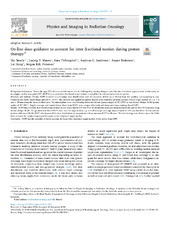| dc.contributor.author | Busch, Kia | |
| dc.contributor.author | Muren, Ludvig Paul | |
| dc.contributor.author | Thørnqvist, Sara | |
| dc.contributor.author | Andersen, Andreas G. | |
| dc.contributor.author | Pedersen, Jesper | |
| dc.contributor.author | Dong, Lei | |
| dc.contributor.author | Petersen, Jørgen Brede Baltzer | |
| dc.date.accessioned | 2020-04-20T19:39:41Z | |
| dc.date.available | 2020-04-20T19:39:41Z | |
| dc.date.issued | 2019-01 | |
| dc.Published | Busch K, Muren LP, Thørnqvist S, Andersen AG, Pedersen J, Dong, Petersen JBB. On-line dose-guidance to account for inter-fractional motion during proton therapy. Physics and imaging in radiation oncology (PIRO). 2019;9:7-13 | eng |
| dc.identifier.issn | 2405-6316 | en_US |
| dc.identifier.uri | https://hdl.handle.net/1956/21945 | |
| dc.description.abstract | Background and purpose Proton therapy (PT) of extra-cranial tumour sites is challenged by density changes caused by inter-fractional organ motion. In this study we investigate on-line dose-guided PT (DGPT) to account inter-fractional target motion, exemplified by internal motion in the pelvis. Materials and methods On-line DGPT involved re-calculating dose distributions with the isocenter shifted up to 15 mm from the position corresponding to conventional soft-tissue based image-guided PT (IGPT). The method was applied to patient models with simulated prostate/seminal vesicle target motion of ±3, ±5 and ±10 mm along the three cardinal axes. Treatment plans were created using either two lateral (gantry angles of 90°/270°) or two lateral oblique fields (gantry angles of 35°/325°). Target coverage and normal tissue doses from DGPT were compared to both soft-tissue and bony anatomy based IGPT. Results DGPT improved the dose distributions relative to soft-tissue based IGPT for 39 of 90 simulation scenarios using lateral fields and for 50 of 90 scenarios using lateral oblique fields. The greatest benefits of DGPT were seen for large motion, e.g. a median target coverage improvement of 13% was found for 10 mm anterior motion with lateral fields. DGPT also improved the dose distribution in comparison to bony anatomy IGPT in all cases. The best strategy was often to move the fields back towards the original target position prior to the simulated target motion. Conclusion DGPT has the potential to better account for large inter-fractional organ motion in the pelvis than IGPT. | en_US |
| dc.language.iso | eng | eng |
| dc.publisher | Elsevier | en_US |
| dc.rights | Attribution-NonCommercial-NoDerivs CC BY-NC-ND | eng |
| dc.rights.uri | http://creativecommons.org/ licenses/by-nc-nd/4.0/ | eng |
| dc.title | On-line dose-guidance to account for inter-fractional motion during proton therapy | en_US |
| dc.type | Peer reviewed | |
| dc.type | Journal article | |
| dc.date.updated | 2020-02-13T09:43:42Z | |
| dc.description.version | publishedVersion | en_US |
| dc.rights.holder | Copyright 2018 Elsevier | en_US |
| dc.identifier.doi | https://doi.org/10.1016/j.phro.2018.11.009 | |
| dc.identifier.cristin | 1741054 | |
| dc.source.journal | Physics and imaging in radiation oncology (PIRO) | |

